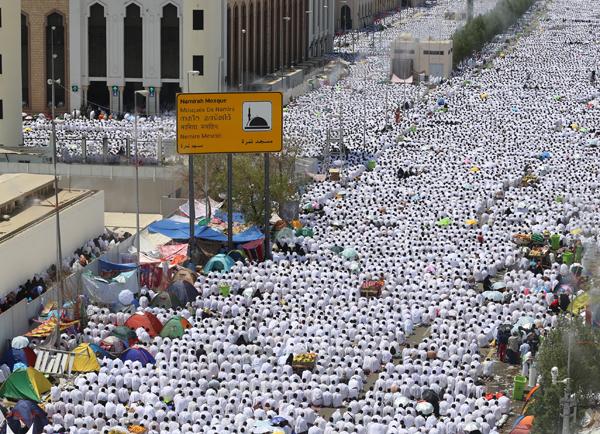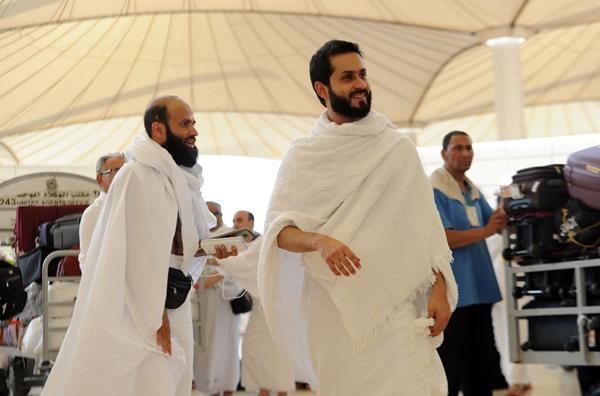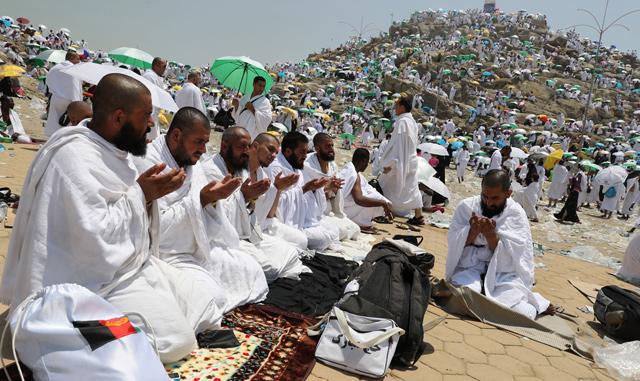You are here
Drones keep watch as pilgrims ascend Mount Arafat for Hajj climax
By Reuters - Sep 13,2016 - Last updated at Sep 13,2016

Muslim pilgrims perform prayer at Namirah Mosque in Mecca, Saudi Arabia, on Sunday ahead of the climax of Hajj (Anadolu photo)
ARAFAT — Saudi authorities deployed drones to watch over nearly 2 million pilgrims as they ascended Mount Arafat at the climax of the Hajj on Sunday, part of stepped up efforts to avoid a repeat of last year’s crush amid an escalating war of words with Iran.
In one of the deadliest disasters to befall the annual Muslim rite in decades, the crush last year killed nearly 800 pilgrims, according to Riyadh, though counts by countries of repatriated bodies showed over 2,000 people may have died, more than 400 of them Iranians.
Chanting “here I am at thy service, O Lord”, the faithful climbed the craggy hills outside Mecca where Islam holds that God tested Abraham’s faith by commanding him to sacrifice his son Ismail and the Prophet Mohammed gave his last sermon.
“I have prayed to God to have mercy on us, give us relief and resolve Syria’s crisis,” said Um Fadi, wearing a traditional long black embroidered dress and head scarf native to her home in southern Syria.
Saudi Arabia has said that 1.85 million pilgrims, most of them from outside Saudi Arabia, have arrived for the annual pilgrimage, a religious duty for every able-bodied Muslim who can afford the journey.
Saudi Arabia stakes its reputation on its guardianship of Islam’s holiest sites and organising Hajj, a role that Iranian authorities have challenged this week as part of an escalating war of words over the handling of last year’s disaster.
The grand mufti, the kingdom’s top religious authority, warned Iran that to disrupt the Hajj would be unacceptable, in comments reported by local daily Al Okaz on Sunday.
“Any policy that aims to divert the Hajj from its proper course is un-Islamic and is a criminal policy,” he was quoted as saying.
Crowd control
Saudi Arabia’s state news agency also published a four-part broadside accusing Iran’s leaders of using “the cloak of religion to implement heretical policies”. The series said 300 Iranian pilgrims caused last year’s crush by taking a wrong turn in the direction opposite to where they had been assigned to move.
Saudi authorities have previously suggested that pilgrims failing to follow crowd control rules bore some blame for the disaster, but have not released any further details. An investigation into the incident is still pending.
Earlier in the week, Iran’s supreme leader accused Saudi authorities of murdering pilgrims during the crush. In response, Saudi Arabia’s mufti said Iran’s leaders were not Muslims.
Pilgrims from Iran are not attending Hajj this year, after talks between the two Middle East powers over Hajj arrangements broke down in May.
The 2015 crush, in which two large groups of pilgrims arrived together at a crossroads in Mina, a few kilometres east of Mecca, on their way to performing the “stoning of the devil” ritual at Jamarat, was the worst disaster to strike the annual pilgrimage for at least 25 years.
The Saudi authorities redesigned the Jamarat area after two stampedes, one in 2004 and one in 2006, killed hundreds of pilgrims, and the frequency of such disasters has greatly reduced as the government spent billions of dollars upgrading and expanding Hajj infrastructure and crowd control technology.
Authorities have deployed drones to reinforce a network of electronic surveillance of the crowds that would alert authorities to intervene quickly if necessary.
Pilgrims used buses, trains and private cars to move from their encampments in Mena to Mount Arafat.
They will spend the day on the mountain and move by sunset to the rocky plain of Muzdalifa, where they will gather pebbles to stone columns symbolising the devil at another location called Jamarat on Monday, which marks the first day of Eid Al Adha (feast of sacrifice).
Related Articles
RIYADH — A year after the worst Hajj disaster in a generation, Saudi Arabia is issuing pilgrims with electronic bracelets and using more sur
MOUNT ARAFAT, KSA — A sea of pilgrims ascended Mount Arafat in Saudi Arabia on Monday to pray and repent, the climax of the annual Hajj brin
MECCA — From Asia, Africa and points in between, nearly 1.5 million Muslims began the annual Hajj (the greater Muslim pilgrimage to Mecca) i














